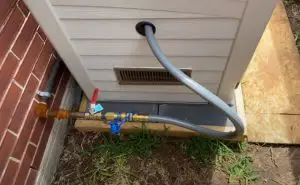Standby generators that run on gas require a gas line that facilitates the transfer of gas to the unit. But what size gas line is required for a standby generator? This guide will help you determine the right size of gas line for your standby generator.
What Gas Pressure is Required For a Standby Generator?
Different tables, sizes, and distances apply if you’re utilizing liquid natural gas (LNG) as your generator’s primary fuel source. Follow the instructions in the generator’s handbook to the letter to get the proper gas pressure.
At the generator inlet, a 1-inch gas line should be used for water columns of 5 to 7 inches, while a 1.25-inch gas line should be used for water columns of 30 to 305 feet.
Does a Generator Need a Dedicated Gas Line?
A standby generator does not require a dedicated gas line. However, if you don’t run a separate line, then your home, shop or building gas line will need to be extended in order for a qualified firm to install your new gas-powered standby generator.
Extending an existing gas line (assuming it’s already adequately sized) will only take a few hours, and it will be the most affordable element of the generator installation.
This video illustrates how a standby generator is properly connected to a gas line, and the special considerations you need to take into account:
Related Questions and Answers
How much natural gas does a 22 kW generator use?
If a 22 kW generator is running at maximum capacity, it will use approximately 7 to 10 cubic meters of natural gas per day. As long as it’s connected directly to your natural gas pipes, you’ll be able to keep your house functioning.
How much does it cost to run a gas line for a generator?
Per linear foot, installing a gas line to a generator costs between $20 and $25. It is necessary to hire an experienced plumber to run a line to the generator when it is installed.
Can you hook up a portable generator to your house gas line?
A portable gas generator may be hooked up to your home natural gas line, but the process can be complicated. The necessary fittings and lines must be installed by a trained professional. Of course, this also assumes your portable generator runs on propane or liquid natural gas (LNG), as the case may be. If not, you’ll need to convert your portable generator to run on gas before hooking it up.
Can you hook up a standby generator to your existing gas line?
Yes, when utilizing natural gas or propane to power your standby generator, you can connect the generator itself to your home, shop or industrial building natural gas line or propane tank. This must be done by a certified professional, and the generator must be properly sized to the line size so it does not exceed the combined volume needed to generate electricity and run the appliances of the home at the same time.
In addition, you must ensure that the gas valves you choose for your home generator installation are suitable for the sort of gas you want to use and the volume of gas consumed by the generator.
Recommended gas lines
DOZYANT 15 Foot 3/4inch ID Natural Gas Hose with Quick Connect/Disconnect Fittings
Propane Natural Gas Kit Generator Robin Subaru EX27 EX30 EX40 Alternative Fuel
M.B. Sturgis Inc. 3/4″ ID Natural Gas Generator Quick Disconnect Gas Connector (25 Foot)
What type of gas regulator do I need for a standby generator?
A 1-1/2″ gas regulator with an upstream gas pressure of 2 psi would be the most appropriate option.
How far does a gas regulator have to be from a generator?
The gas regulator safety relief valve (vent opening) must not be within 5 feet of any possible source of ignition, including the generator itself. It also cannot be located within 5 feet of any ventilation air intake.
How many gas regulators does a generator need?
Two gas regulators should be used when running a gas generator. One regulator should be located in the propane or LNG tank to reduce tank pressure to ten pounds. A half-inch copper line then connects the tank regulator to a second regulator located near the generator.
Is it normal to smell gas from a standby generator?
A gas regulator allows you to fine-tune how much gas is delivered to your generator. Occasionally, it may “burp” or “bleed” out a little quantity of gas in order to prevent the pressure in the gas line or tank from being too high. So, yes, it is common to detect a mild odor of gas coming from the gas regulator near your standby generator.
Can a gas regulator be installed upside down?
This depends on the make and model of the gas regulator. Some gas regulators are designed to be installed in any orientation, even upside down. Others must be installed in accordance with the manufacturer’s instructions.
Can a propane generator use natural gas?
Yes. There are conversion kits available for various propane generator models that allow them to operate on liquid natural gas (LNG). The orifice through which natural gas passes must be altered to accommodate the difference in pressure of the gas. Propane-to-natural gas conversion kits generally cost less than $300.
Conclusion
Although a gas generator does not need a dedicated gas line, it is recommended to install one. This makes fitting it onto a property easier, while not having to change the layout very much.
Remember, a “standby generator gas line size” is usually a 1-inch or 1.25-inch gas line.
NEXT UP: Do Standby Generators Need a Ground?
Related Tags
- generac generator gas pipe sizing chart
- running lp gas line to generator
- what size gas line is needed for a whole house generator
- gas line for whole house generator
- generac 16kw generator gas line size

